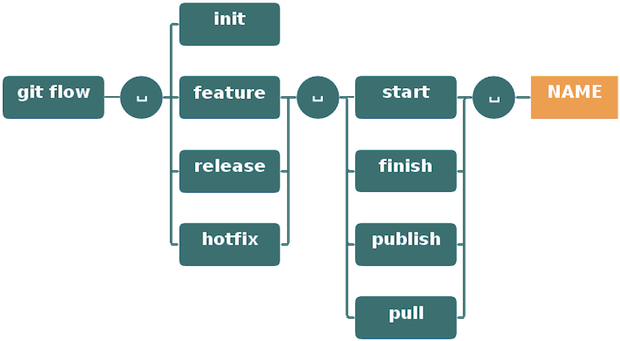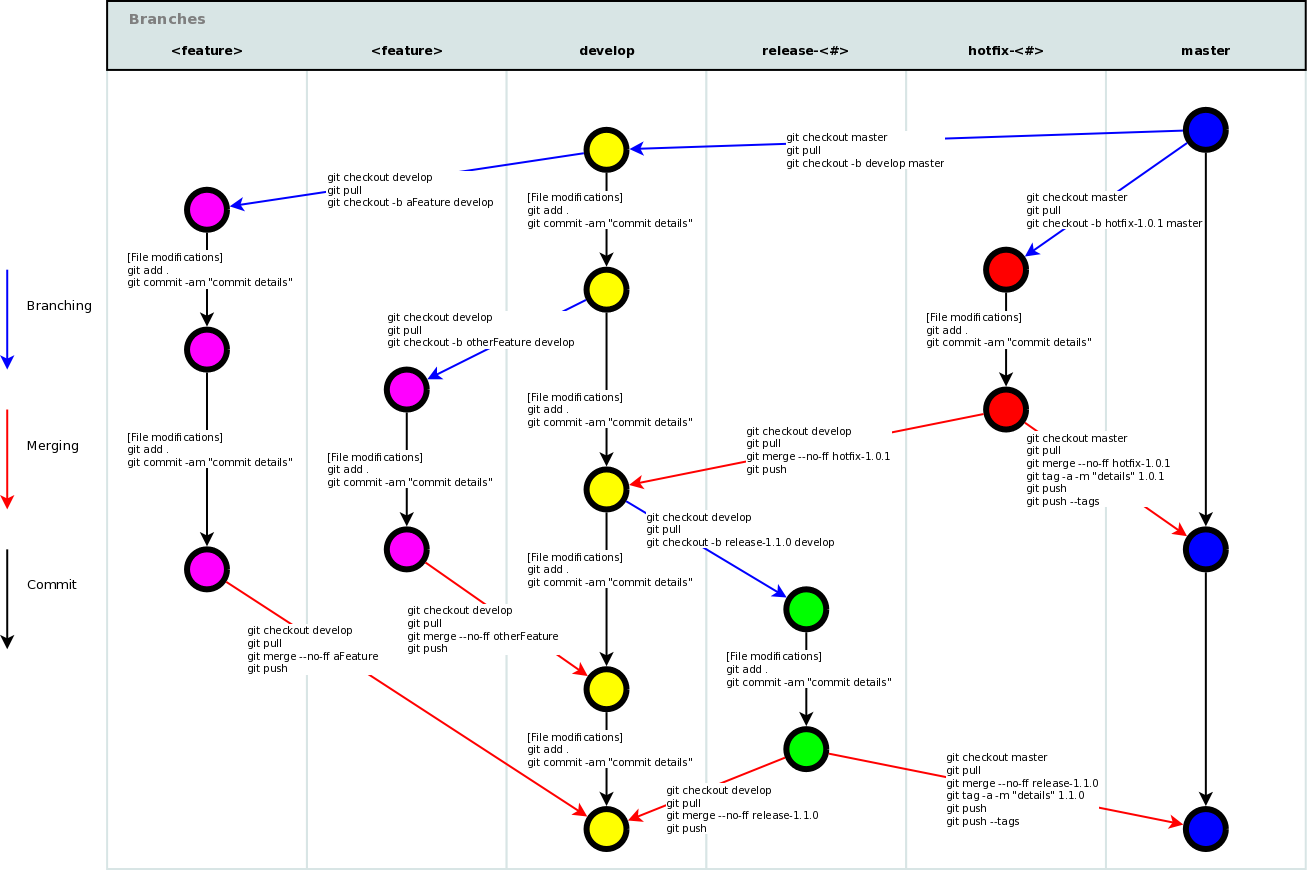Git 和 Git Flow 备忘单  ¶
¶

Other Available Languages:¶
- Arabic Git Cheat Sheet
- Brazilian Portuguese Git Cheat Sheet
- Chinese Git Cheat Sheet
- German Git Cheat Sheet
- Greek Git Cheat Sheet
- Hindi Git Cheat Sheet
- Korean Git Cheat Sheet
- Polish Git Cheat Sheet
- Spanish Git Cheat Sheet
- Turkish Git Cheat Sheet
- Bengali Git Cheat Sheet
Git 备忘单使您无需背诵所有命令.
可以自由贡献,更新语法错误. 您也可以自由添加您的语言文件.
Git 备忘单英文¶
Index¶
Setup¶
Show current configuration:¶
$ git 配置 --list
Show repository configuration:¶
$ git 配置 --local --list
Show global configuration:¶
$ git 配置 --global --list
Show system configuration:¶
$ git 配置 --system --list
Set a name that is identifiable for credit when review version history:¶
$ git config --global user.name "[名字姓氏]"
Set an email address that will be associated with each history marker:¶
$ git config --global user.email “[有效电子邮件]”
Set automatic command line coloring for Git for easy reviewing:¶
$ git config --global color.ui auto
Set global editor for commit¶
$ git config --global core.editor vi
Configuration Files¶
Repository specific configuration file [--local]:¶
<repo>/.git/config
User-specific configuration file [--global]:¶
~/.gitconfig
System-wide configuration file [--system]:¶
/etc/gitconfig
Create¶
Clone an existing repository:¶
有两种方式:
通过 SSH
$ git clone ssh://user@domain.com/repo.git
通过 HTTP
$ git clone http://domain.com/user/repo.git
Create a new local repository in the current directory:¶
$ git 热量
Create a new local repository in a specific directory:¶
$ git 热量<directory>
Local Changes¶
Changes in working directory:¶
$ git 状态
Changes to tracked files:¶
$ 比较差异
See changes/difference of a specific file:¶
$ 比较差异<file>
Add all current changes to the next commit:¶
$ 混帐添加.
Add some changes in <file> to the next commit:¶
$ git 添加 -p<file>
Add only the mentioned files to the next commit:¶
$ 添加<filename1><filename2>
Commit all local changes in tracked files:¶
$ git 提交 -a
Commit previously staged changes:¶
$ git 提交
Commit with message:¶
$ git commit -m '这里的消息'
Commit skipping the staging area and adding message:¶
$ git commit -am '这里的消息'
Commit to some previous date:¶
$ git commit --date="`date --date='n 天前'`" -am "<Commit Message Here> “
Change last commit:
¶
不要修改已发布的提交!
$ git commit -a --amend
Amend with last commit but use the previous commit log message¶
不要修改已发布的提交!
$ git commit --amend --no-edit
Change committer date of last commit:¶
GIT_COMMITTER_DATE="日期" git commit --amend
Change Author date of last commit:¶
$ git commit --amend --date="日期"
Move uncommitted changes from current branch to some other branch:
¶
$ git 存储
$ git checkout 分支 2
$ git 存储弹出
Restore stashed changes back to current branch:¶
$ git 存储应用
Restore particular stash back to current branch:¶
- {stash_number} 可以从
git stash list获得
$ git stash apply stash@{stash_number}
Remove the last set of stashed changes:¶
$ git 藏起来
Search¶
A text search on all files in the directory:¶
$ git grep “你好”
In any version of a text search:¶
$ git grep “你好” v2.5
Show commits that introduced a specific keyword¶
$ git log -S '关键字'
Show commits that introduced a specific keyword (using a regular expression)¶
$ git log -S '关键字' --pickaxe-regex
Commit History¶
Show all commits, starting with newest (it'll show the hash, author information, date of commit and title of the commit):¶
$ git 日志
Show all the commits(it'll show just the commit hash and the commit message):¶
$ git 日志 --oneline
Show all commits of a specific user:¶
$ git log --author="用户名"
Show changes over time for a specific file:¶
$ git 日志 -p<file>
Display commits that are present only in remote/branch in right side¶
$ git 日志 --oneline<origin/master> ..<remote/master> - 左右
Who changed, what and when in <file>:¶
$ git 责备<file>
Show Reference log:¶
$ git reflog 显示
Delete Reference log:¶
$ git reflog 删除
Move / Rename¶
Rename a file:¶
将 Index.txt 重命名为 Index.html
$ git mv 索引.txt 索引.html
Branches & Tags¶
List all local branches:¶
$ 分支
List local/remote branches¶
$ git 分支 -a
List all remote branches:¶
$ git 分支 -r
Switch HEAD branch:¶
$ 结帐<branch>
Checkout single file from different branch¶
$ 结帐<branch> --<filename>
Create and switch new branch:¶
$ 结帐-b<branch>
Switch to the previous branch, without saying the name explicitly:¶
$ 结帐 -
Create a new branch from an exiting branch and switch to new branch:¶
$ 结帐-b<new_branch><existing_branch>
Checkout and create a new branch from existing commit¶
$ 结帐<commit-hash> -b<new_branch_name>
Create a new branch based on your current HEAD:¶
$ 分支<new-branch>
Create a new tracking branch based on a remote branch:¶
$ git 分支 --track<new-branch><remote-branch>
Delete a local branch:¶
$ git 分支 -d<branch>
Rename current branch to new branch name¶
$ git 分支 -m<new_branch_name>
Force delete a local branch:¶
您将丢失未合并的更改!
$ git 分支 -D<branch>
Apply specific commit from another branch:¶
git 樱桃挑选<commit hash>
Mark HEAD with a tag:¶
$ git 标签<tag-name>
Mark HEAD with a tag and open the editor to include a message:¶
$ git 标签 -a<tag-name>
Mark HEAD with a tag that includes a message:¶
$ git 标签<tag-name> -am '消息在这里'
List all tags:¶
$ git 标签
List all tags with their messages (tag message or commit message if tag has no message):¶
$ git 标签 -n
Update & Publish¶
List all current configured remotes:¶
$ git 远程 -v
Show information about a remote:¶
$ git 远程显示<remote>
Add new remote repository, named <remote>:¶
$ git 远程添加<remote><url>
Rename a remote repository, from <remote> to <new_remote>:¶
$ git 远程重命名<remote><new_remote>
Remove a remote:¶
$ git 远程 rm<remote>
注意:git remote rm 不会从服务器上删除远程仓库. 它只是从本地存储库中删除远程及其引用.
Download all changes from <remote>, but don't integrate into HEAD:¶
$ git 获取<remote>
Download changes and directly merge/integrate into HEAD:¶
$ git 远程拉取<remote><url>
Get all changes from HEAD to local repository:¶
$ git pull 起源大师
Get all changes from HEAD to local repository without a merge:¶
$ git pull --rebase<remote><branch>
Publish local changes on a remote:¶
$ git 推送<remote><branch>
Delete a branch on the remote:¶
$ git 推送<remote> :<branch> (自 Git v1.5.0 起)
$ git 推送<remote> - 删除<branch> (自 Git v1.7.0 起)
Publish your tags:¶
$ git push --tags
Configure the merge tool globally to meld (editor)¶
$ git config --global merge.tool meld
Use your configured merge tool to solve conflicts:¶
$ 合并工具
Merge & Rebase¶
Merge branch into your current HEAD:¶
$ git 合并<branch>
List merged branches¶
$ git 分支 --merged
Rebase your current HEAD onto <branch>:
¶
不要变基已发布的提交!
$ 混帐狐狸<branch>
Abort a rebase:¶
$ git rebase --abort
Continue a rebase after resolving conflicts:¶
$ git rebase --continue
Use your editor to manually solve conflicts and (after resolving) mark file as resolved:¶
$ 添加<resolved-file>
$ git rm<resolved-file>
Squashing commits:¶
$ git rebase -i<commit-just-before-first>
现在更换这个,
挑选<commit_id>
挑选<commit_id2>
挑选<commit_id3>
对此,
挑选<commit_id>
壁球<commit_id2>
壁球<commit_id3>
Undo¶
Discard all local changes in your working directory:¶
$ git reset --hard HEAD
Get all the files out of the staging area(i.e. undo the last git add):¶
$ git 重置 HEAD
Discard local changes in a specific file:¶
$ git 结帐头<file>
Revert a commit (by producing a new commit with contrary changes):¶
$ git 恢复<commit>
Reset your HEAD pointer to a previous commit and discard all changes since then:¶
$ git reset --hard<commit>
Reset your HEAD pointer to a remote branch current state.¶
$ git reset --hard<remote/branch> 例如,upstream/master,origin/my-feature
Reset your HEAD pointer to a previous commit and preserve all changes as unstaged changes:¶
$ git 重置<commit>
Reset your HEAD pointer to a previous commit and preserve uncommitted local changes:¶
$ git 重置 --keep<commit>
Remove files that were accidentally committed before they were added to .gitignore¶
$ git rm -r --cached .
$ 混帐添加.
$ git commit -m "删除 xyz 文件"
Git-Flow¶
Improved Git-flow
Index¶
Setup¶
You need a working git installation as prerequisite. Git flow works on OSX, Linux and Windows.¶
OSX Homebrew:¶
$ brew 安装 git-flow-avh
OSX Macports:¶
$ 端口安装 git-flow
Linux (Debian-based):¶
$ sudo apt-get 安装 git-flow
Windows (Cygwin):¶
You need wget and util-linux to install git-flow.¶
$ wget -q -O - --no-check-certificate https://raw.githubusercontent.com/petervanderdoes/gitflow/develop/contrib/gitflow-installer.sh 安装<state> | 狂欢
Getting Started¶
Git flow needs to be initialized in order to customize your project setup. Start using git-flow by initializing it inside an existing git repository:¶
Initialize:¶
You'll have to answer a few questions regarding the naming conventions for your branches. It's recommended to use the default values.¶
git 流初始化
To use default¶
git 流初始化 -d
Features¶
Develop new features for upcoming releases. Typically exist in developers repos only.¶
Start a new feature:¶
This action creates a new feature branch based on 'develop' and switches to it.¶
git flow 功能启动 MYFEATURE
Finish up a feature:¶
Finish the development of a feature. This action performs the following:¶
1) Merged MYFEATURE into 'develop'.¶
2) Removes the feature branch.¶
3) Switches back to 'develop' branch¶
git flow 功能完成 MYFEATURE
Publish a feature:¶
Are you developing a feature in collaboration? Publish a feature to the remote server so it can be used by other users.¶
git flow 功能发布 MYFEATURE
Getting a published feature:¶
Get a feature published by another user.¶
git 流功能拉源 MYFEATURE
Tracking a origin feature:¶
You can track a feature on origin by using¶
git flow 功能跟踪 MYFEATURE
Make a Release¶
Support preparation of a new production release. Allow for minor bug fixes and preparing meta-data for a release¶
Start a release:¶
To start a release, use the git flow release command. It creates a release branch created from the 'develop' branch. You can optionally supply a [BASE] commit sha-1 hash to start the release from. The commit must be on the 'develop' branch.¶
git flow release start RELEASE [BASE]
It's wise to publish the release branch after creating it to allow release commits by other developers. Do it similar to feature publishing with the command:¶
git flow release 发布 RELEASE
(You can track a remote release with the: git flow release track RELEASE command)¶
Finish up a release:¶
Finishing a release is one of the big steps in git branching. It performs several actions:¶
1) Merges the release branch back into 'master'¶
2) Tags the release with its name¶
3) Back-merges the release into 'develop'¶
4) Removes the release branch¶
git flow 发布完成 RELEASE
Don't forget to push your tags with git push --tags¶
Hotfixes¶
Hotfixes arise from the necessity to act immediately upon an undesired state of a live production version. May be branched off from the corresponding tag on the master branch that marks the production version.¶
Git flow hotfix start:¶
Like the other git flow commands, a hotfix is started with¶
$ git flow hotfix start VERSION [BASENAME]
The version argument hereby marks the new hotfix release name. Optionally you can specify a basename to start from.¶
Finish a hotfix:¶
By finishing a hotfix it gets merged back into develop and master. Additionally the master merge is tagged with the hotfix version¶
git flow 修补程序完成版本
Commands¶

Git flow schema¶
